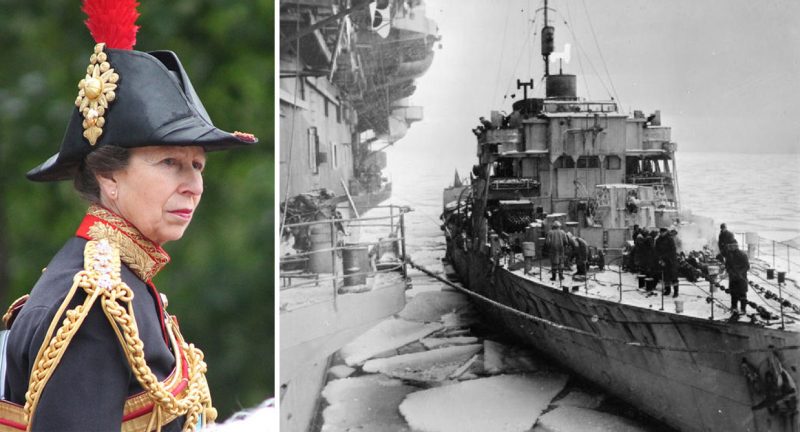Struggling to remove heavy ice off the decks of your ship while it is dangerously rolling in the icy waters of the Arctic is neither a safe, nor a pleasant task. During WWII, many sailors on the Arctic Convoys braved these hardships. The trip was made even more dangerous by the knowledge that while you were busy, there was a strong possibility that your ship would be attacked and sunk by the enemy.
Princess Anne, the British Princess Royal, was in Arkhangelsk (Russia) attending a number of ceremonies, marking the 75th anniversary of the arrival of the first of the Allied Arctic convoys in that city. These convoys braved the awful Arctic conditions, in order to carry supplies to the USSR which were vital in its fight against Nazi Germany.
During her speech on the occasion, Princess Anne spoke on behalf of her Majesty the Queen, expressing how grateful the British were for the sacrifices made by the sailors on these convoys. Tribute was also due to the bravery of the Soviet veterans who had fought together with the British military, she said. On this special occasion, the Arctic Star medal, (awarded to those who served on the Arctic convoys) was presented by Princess Anne, to the Maritime Museum in Arkhangelsk.
The very first of the Arctic convoys, code-named Dervish, left Hvalfjord (Iceland) on 21st August 1941, arriving at Arkhangelsk on 31st August 1941. It comprised six merchant ships loaded with various raw materials, munitions and medical supplies, together with 15 boxed Hurricane fighter planes. It was escorted by three destroyers, three minesweepers, and three anti-submarine trawlers, the additional distant cover was supplied by a heavy cruiser and three extra destroyers, while an old aircraft carrier delivered 24 Hurricanes (of the RAF’s 151 Fighter Wing) to Vaenga, near to Murmansk. Those who sailed during operation ‘Dervish’ had beginners luck – the convoy suffered no losses, all arriving safely at their destination.
Thousands of sailors subsequently braved freezing temperatures and the constant threat of attacks, to deliver vital provisions, ammunition and fighter planes to the USSR. These convoys sailed via the shortest route to the ports of Murmansk and Arkhangelsk, which required sailing through the dangerous Nazi-occupied Arctic waters above Norway. In the 78 Arctic Convoys undertaken from August 1941 to May 1945, some 1,400 merchant ships managed to deliver over 4 million tons of supplies essential to the Soviet Union. Some convoys suffered heavy losses, for not all were as successful as the Dervish, as the Nazis managed to sink over 100 merchant and warships, and caused the loss of over three thousand sailors.
Besides the Nazi warships, submarines and the Luftwaffe aircraft, the convoys had to face heavy Arctic storms; with rough seas and such low temperatures that water washing over the decks froze. Constant de-icing of the decks, as well as the guns, became part of the sailor’s routine. In the words of Bill Smith, a sailor from the HMS Magpie; “the deck was covered in ice and snow, and we had to use lifelines when going aft to the guns and depth charges … Your eyebrows and eyelashes froze, and your eyes were very sore with the winds blowing into them … the main thing at this time was to keep the upper deck clear of ice and snow using axes and steam hoses or the ship could become top heavy.”
Also commemorating the bravery of these men, the Consul General of the Russian Federation held a reception in Edinburgh, for the Scottish WWII veterans, as a mark of gratitude for their role in the convoys. Russia has not forgotten these brave men, for many of the UK veterans of these WWII Arctic convoys, have been honoured by the award of the prestigious Ushakov medal which is given, for courage and bravery. It has taken years for these men to be officially recognized, due to red-tape regarding receipt of awards from foreign nations. The matter was finally resolved and the medals presented by the Attaché of the Russian Embassy, Oleg Shor. Over 3,000 veterans have been included in the list of those entitled to receive the honour.
As part of the commemoration ceremony marking the 75th Anniversary of the arrival of the first Arctic Convoy in Arkhangelsk, the Princess Royal attended the military parade, held by the city, which involved both battleships and aircraft. Many WWII veterans and delegates from Russia, the UK, the USA, Canada, Australia, France, New Zealand, Iceland, Poland and the Netherlands, attended these Arkhangelsk anniversary ceremonies. This showed that so many people and so many countries remembered their heroes.
Many of the Allied WWII veterans at the Arkhangelsk events have kept up friendly relations with the former Soviet veterans living in Russia. Some of the veterans stated that they do not share the often expressed anti-Russian sentiments, and one of them said: “If we keep friendship at this level… then hopefully we can influence the politicians.” Perhaps that is something for which we should all strive.
